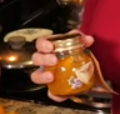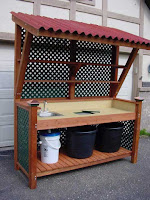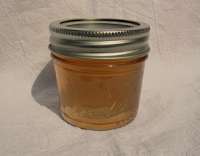
Mel's latest money making venture. Namely, becoming a chicken farmer. Her plan includes selling chicks, pullets, cockerels, layers, roosters, and eggs. She has narrowed the breeds to two with a possible third: Americana and Rhode Island Reds with Buff Orpingtons as a possible third.
We are well versed in the hatching, raising, and caring for two of these breeds. Currently owning Buff Orpington and Rhode Island Reds, we have learned their personalities and manners. We love both of these breeds and highly recommend both breeds for southern homesteaders. Both of these are dual purpose (meat & eggs) breeds with cream to brown, large eggs. They are prolific egg layers.

The new kid on the block will be the Americana breed. They are a cross breed of Ameraucana and Araucana breed chicken. As a novelty egg layer, hens lay colored eggs between olive green, blue, and turquoise eggs. The layers are less robust than the orpingtons and the reds, but about 240, medium sized eggs a year. Just think, no chemically dyed Easter eggs for Easter!
We may be adding some Silkies are mother hens since they have a great reputation for broodiness and mothers. We'd much rather raise chicks the way Mother Nature intended. While Rhode Island Reds RIR) are not known for broodiness, our Black Butt has turned out to be an excellent mother just as Broody. aka Gimpy, was to her last brood of New Hampshire Red chicks. I'm holding out for Goldie, our remaining Buff hen, to go broody. That breed is supposed to be broody, but she hasn't yet at two years old.
So we are getting a jump start on hatching some chicks of our own with our cockeyed incubator. (Instruction below)Yes, we know it's late October, but we're just in an experimenting stage. These eggs we've gathered from our free range birds could have been fertilized by Big Red (RIR) or Hoo-de-ho, our Buff rooster, or not fertilized at all. We'll have to wait and see.
In the meantime, we set up the our cockeyed incubator today. Now we have a standard electric incubator, but we've had better hatch rate this way. We've managed only a 75% hatch rate with the electric incubator with ours Mel managed 6 chicks from 6 eggs. (it may have been beginner's luck too.) In case you can't figure it out, that's 100% hatch rate.
So, do you want to know how we did it? This time I took pictures while Mel set it up.
Our Cockeyed Incubator
(it was copied from similar models on YouTube)
What you'll need
An 18-gallon tote
A heating pad (ours has three settings low, high, and off)
Several beach towels
A small bowl
A sponge
Light fixture with 100-watt bulb, we use our brooder box light
A temperature probe (mine was one I used as a chef)
A pencil
Unrefrigerated eggs, 1 week or less old
 Putting it together
Putting it together
 Step 1
Step 1
We laid a heating pad on a folded a beach towel fold it into quarters. We
turned the heating pad on high. Our heating pad is an older model that does not cycle off when the temperature has been on too long.
STEP 2
We folded another towel and placed it inside the container. This gave the eggs a comfortable cushion with a cotton pillowcase for the eggs and to stabilize them. We can bunch up the pillowcase easier than the towel to keep the eggs in position.
 STEP 3
STEP 3
Next we placed a thermometer in the tote and the 100 watt bulb in the tote.Notice we have not punched any holes in the tote. We can reuse this tote for a large optional storage solutions later after cleaning it with bleach, soap and hot water.
STEP 4
We placed a small bowl and a sponge in the corner away from the eggs but still on the heating pad.We poured boiling hot water over the sponge Enough to soak the sponge
and leave 1/2" in the bowl. You'll maintain this until hatching is
complete.
STEP 5
Check your eggs carefully. If one appear abnormally large, it's probably a double yolked egg. (Miss Greedy Piggy is notorious for giving one of these a week). It may not hatch or develop twins. Not a good choice for hatching, but wonderful for baking with. Some eggs may have tiny cracks or a hole in the shell. These are also good candidates for hatching. Heavily soiled eggs (feces or dirt) also should not be incubated also. Have them for breakfast instead. Two of our "to be hatched" fell into this category so we are hatching 9 instead of 12.
STEP 6
Take each egg an draw an "O" on one side and an "X" on the other with a pencil. I know some people who do this with a marker, but I have concerns of the chemicals leaching through the porous shell. Do you know what chemicals or dyes are in a Sharpie marker, I don't either so I don't want it anywhere near my chicks.
We'll place the marked eggs onto the towel "O" side up.
STEP 7
We will be manually turning these eggs four times a day until day 17. The "X"s and "O"s will tell us it has been done without yelling at each other to ask. We start at "O"s and the evening it's "X"s. Then we'll start again at "O"s again in the morning.
When we open the box to turn them, we lose all that lovely humidity and warmth the eggs need so we'll pour some hot, steamy water into the bowl before we close the lid again. Each morning turn, we'll empty the bowl, squeeze the sponge, and add fresh boiled water again to the bowl.
STEP 8
Place the container lid on the container. To regulate the temperature, simply open the lid part way if it's too warm. If more heat is needed, cover the whole tote with a blanket. Remember to plug the cords into a power strip and make sure it works. Do not add your eggs until you reach 99 degrees in the tote. It will do so in a few hours. We do a standard 12 hours and check it frequently.
We will candle these eggs when we stop rotating them. We will discard any unfertilized eggs. It's doubtful with two roosters doing their rooster business on the so few egg layers, but it can happen, right?
***************
With our
nighttime lows dipping into the low 50s, we cover them at night too to help maintain the temperature overnight. We
don't have CH/A, but it's too warm to start a fire in the wood stove so
we do what we can to compensate. Mel has hatched chicks twice now with 100% hatch rate. The first time i
n February 2014, she chocked it up to beginner's luck, but a second time in 2016 was more than beginner's luck.
If the chicks that hatch and survive fall into the RIR/Buff category, the hens will go into the household use (personal use or eggs for sale). Otherwise, (especially cockerels) it's the canner pot for them when they reach harvest age and weight. The true RIR are born, they'll be separated to start Mel's egg farm operation.

That's the plan anyhow. But you know what they say about don't count your chickens before they hatch. Projected hatch date is November 5th or there about. Wish us luck.
Now, in the meantime, I've been researching Pharaoh quails. Since Mel and I are are dark meat fans, it only makes sense, right? They are all dark meat and easy for me to care for and be harvest by me alone. We also have unused rabbit hutches outdoors. I'd only have to redo the hardware cloth, but we have to redo it that anyhow if we move the rabbits outside and we have enough hutches for ten rabbits which we have two. We lost Alby and Moira this week.😥
Mel's on the fence about this. If there's a market for chickens and eggs wouldn't there also be a market for quail? Of course, they wouldn't be free range nor "organic." But, they would be antibiotic free. I imagine I could come up with a seed and grain mixture like I supplement the chickens free range feedings with during winter. Still researching options on this. I can fit a whole lot of quail in two 37" x 29" rabbit cages (5.5 sq ft) plus the surplus rabbit cages we have. I'm just saying, waste not, want not.
Y'all have a blessed day!
Cockeyed Jo

 Do this weekly for the next five weeks- remove the aluminum foil, brush cheesecloth heavily with the syrups, rewrap them in foil, and place back in the refrigerator.
Do this weekly for the next five weeks- remove the aluminum foil, brush cheesecloth heavily with the syrups, rewrap them in foil, and place back in the refrigerator.

































